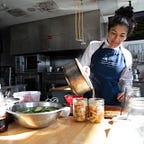how to make duck breast prosciutto at home
All you need is time and patience
Making duck breast prosciutto is easier than you think. But even though the process is simple — using salt to draw water from the meat and to create an inhospitable environment for bad bacteria to grow — it’s still slightly scary to hang meat outside of the refrigerator for almost three weeks. The key is to keep it cool enough (50–65F) to slow down decomposition while it dries out, which is easier here in Denver’s semi-arid climate.
This is not new knowledge. Humans across the world have been preserving meats for millenia creating food traditions from stockfish to prosciutto, jerky, and more.
The Process
1- Start with a whole duck. Yes, getting a whole duck means you’ll have two breast, two legs for confit, bounty of fat, and a carcass to make stock. It is actually a much better deal that buying just the breast — which you’ll most likely have to do online and pay a premium.
2- Once you fabricate the duck, salt the breast and legs — use 3 tbsp of salt, 1 crushed bay leaf, 1/4 tsp black peppercorn, 1/4 tsp dried thyme (optional). For prosciutto, the breast sits in the salt for two days in the fridge, while the legs are ready after a day.
The legs are great to confit. Take all the skin with the fat from the entire bird and melt it on a pot at low heat. Once you have a good base [this can take 30 minutes or so], remove the bits of leathery skin left and add the legs to the melted fat. Poach for 2 hours or until the meat is tender. Cool the legs in the fat until ready to use — to flavor beans, caramelize and eat with some potatoes, or to make rillettes [yum].
3- Once the breast have cured in salt for two days, rinse and air dry in the fridge for 4–6 hours [depending on humidity in your area]. Then wrap them in cheesecloth and hang them in a cool, dry, dark place — in my case my closet is the best place (old, brick house).
4- 10 days later turn the breast upside down and hang it from the other end for 10 more days.
Et Voilà, you have duck breast prosciutto. Here is a super short video of the process.
Now to the Why
1- For my grad research I studied the pig production in Italy. I visited farms, large and small, I ate more prosciutto that I care to admit, and interviewed many producers, small and enormous, all throughout the peninsula. What I found is that the pig industry in Italy, and Europe as a whole, is just like that of the US, and those pigs are the ones used to make the famous Italian cured meats.
After I finished my research, I worked [and worked and worked and worked] with a filmmaker friend with the hopes to make a documentary to show this reality. But, like most European products, Italian cured meats are untouchable by negative commentary, press, or policy. It’s too precious for anyone trying to be a reputable ‘foodie’ to question their charcuterie board, so we never finished the project.
So, even though I love [love, love, love] prosciutto and other cured meats, I abstain from eating them, unless I know their origin.
2- The other reason for duck. To reduce the ecological pressure on chicken. Think about it, every.single.food outlet has chicken [in many forms] as the main star. How many millions [or billions] of chickens is that per day? So, why not use other birds? Guinea fowl, goose, duck, quail?
I hear you, they are more expensive than chicken, but if I have the means to make a choice I will always choose environment over price.
~ Paula
